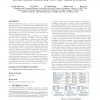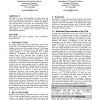300 search results - page 2 / 60 » Extracting Patterns and Relations from the World Wide Web |
WWW
2007
ACM
14 years 6 months ago
2007
ACM
As part of a large effort to acquire large repositories of facts from unstructured text on the Web, a seed-based framework for textual information extraction allows for weakly sup...
WWW
2010
ACM
14 years 17 days ago
2010
ACM
The World-Wide Web consists not only of a huge number of unstructured texts, but also a vast amount of valuable structured data. Web tables [2] are a typical type of structured in...
CHI
1997
ACM
13 years 9 months ago
1997
ACM
In this paper, we report on users' revisitation patterns to World Wide Web (WWW) pages, and use the results to lay an empirical foundation for the design of history mechanism...
AI
2000
Springer
13 years 5 months ago
2000
Springer
The World Wide Web is a vast source of information accessible to computers, but understandable only to humans. The goal of the research described here is to automatically create a...
WWW
2001
ACM
14 years 6 months ago
2001
ACM
WebLQM is a system with capabilities to locate, query and mine web communities on the Internet. WebLQM has a special way to define the World Wide Web, its contents and relations. ...


